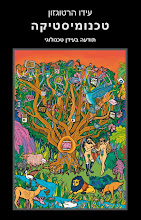
מקדש קיומיזו. צילום: אריה קוץ, סתיו Kyomidzu Temple. Photo: Arie Kutz, Autumn 2006
Kyomidzu Temple, 17th c.
Kyoto East Mountain range
Arie Kutz
Free organization of volumes in space - deconstructivism, 400 years before the word.
A careful and complex orchestration of human movement in space and a fascinating building-nature relationship.
After its first encounter with China, Japan started building formalistic, symmetric Buddhist architecture, formed after the classic Chinese models, but through the ages Japan presents architecture with a clear inclination towards Dao \ Zen Buddhism enriched with Shinto roots.
The relationship between the formal (Confucian) Chinese architecture and the free - Dao oriented architecture recalls the relationship between the holistic Greek architecture and the analytic Roman one.
It will be interesting to compare Kyomizu Temple to the Acropolis in Athens.
מקדש קיומיזו, המאה השבעה עשר
על שרשרת ההרים המזרחית של קיוטו
אריה קוץ
ארגון חופשי של נפחים במרחב - "דה-קונסטרוקטיביזם", כמעט ארבע מאות שנים לפני הולדת המושג.
תכנון תנועה מורכב ומתוזמר.
יחסים מרתקים של בניין-טבע.
יפן החלה את מסעה עם אדריכלות בודהיסטית פורמלית וסימטרית, על פי המודלים הקלאסיים הסיניים, ובמרוצת השנים מציגה דוגמאות אדריכליות עם נטייה מובהקת לכיוון הדאו / זן בודהיזם בשילוב עם שורשי השינטו, המוצאים היזון בונה זה בחיקו של זה.
היחס שבין האדריכלות היוונית לאדריכלות הרומאית מזכיר את היחס שבין האדריכלות הסינית הפורמלית (קונפוציוס) לחופשית (הדאו).
מעניין להשוות עם צורת ארגון המרחב ותכנון התנועה של האקרופוליס באתונה.
ולהשות בין הגישה היוונית ההוליסטית (דאו?) לבין עיבודה בגישה הרומית האנליטית (קונפוציוס?)...
Kyomidzu Temple, 17th c.
Kyoto East Mountain range
Arie Kutz
Free organization of volumes in space - deconstructivism, 400 years before the word.
A careful and complex orchestration of human movement in space and a fascinating building-nature relationship.
After its first encounter with China, Japan started building formalistic, symmetric Buddhist architecture, formed after the classic Chinese models, but through the ages Japan presents architecture with a clear inclination towards Dao \ Zen Buddhism enriched with Shinto roots.
The relationship between the formal (Confucian) Chinese architecture and the free - Dao oriented architecture recalls the relationship between the holistic Greek architecture and the analytic Roman one.
It will be interesting to compare Kyomizu Temple to the Acropolis in Athens.
מקדש קיומיזו, המאה השבעה עשר
על שרשרת ההרים המזרחית של קיוטו
אריה קוץ
ארגון חופשי של נפחים במרחב - "דה-קונסטרוקטיביזם", כמעט ארבע מאות שנים לפני הולדת המושג.
תכנון תנועה מורכב ומתוזמר.
יחסים מרתקים של בניין-טבע.
יפן החלה את מסעה עם אדריכלות בודהיסטית פורמלית וסימטרית, על פי המודלים הקלאסיים הסיניים, ובמרוצת השנים מציגה דוגמאות אדריכליות עם נטייה מובהקת לכיוון הדאו / זן בודהיזם בשילוב עם שורשי השינטו, המוצאים היזון בונה זה בחיקו של זה.
היחס שבין האדריכלות היוונית לאדריכלות הרומאית מזכיר את היחס שבין האדריכלות הסינית הפורמלית (קונפוציוס) לחופשית (הדאו).
מעניין להשוות עם צורת ארגון המרחב ותכנון התנועה של האקרופוליס באתונה.
ולהשות בין הגישה היוונית ההוליסטית (דאו?) לבין עיבודה בגישה הרומית האנליטית (קונפוציוס?)...





















אין תגובות:
הוסף רשומת תגובה